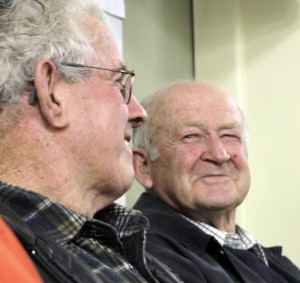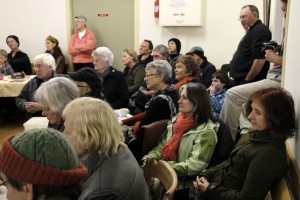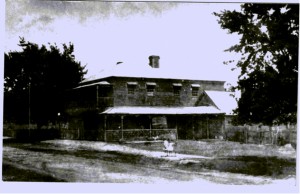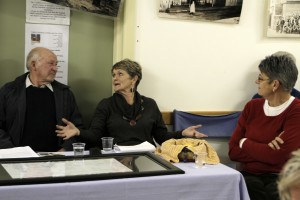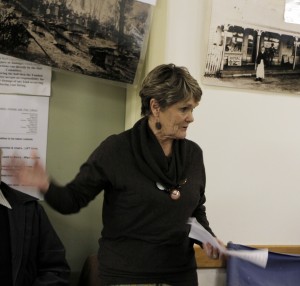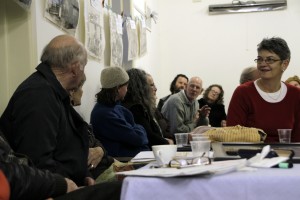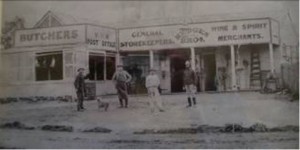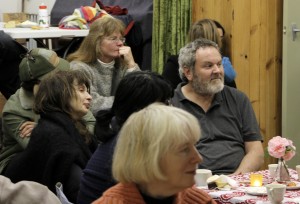Memory keepers Don Morrison, Fleur Smith (nee Staley) and Maurie Gervasoni.
In the beginning-it’s raining stories and laughter
At our first session in August 2013 the hall overflowed with people while voices of story tellers competed with downpours on the roof. We opened with intimate details of creating home and garden, described by Margaret Morrison in an 1856 letter encouraging her Scottish sister to join them in ‘this beautiful valley’ of Yandoit, ‘about half a mile long and not quite so broad’. Listening to Kay O’Connor reading her great, great, great, great grandmother’s letter we saw the creek through a new settler’s eyes ‘running down one side of the valley with almost every description of flowers, beautiful shrubs, and good large trees in bloom growing on its banks’. We learnt of land ploughed to sow oats and wheat and were invited to imagine this ‘mixture of all nations’, this locale which inspired the new minister to remark: ‘I never knew there was such a pretty place’. We appreciated skills passed down through the generations: ‘what a baker I have become’ writes Margaret, ‘making bread, baps, scones and fancy cakes’. Her descendant Kay has a reputation for making the best scones in Yandoit and hers were among many batches generously baked for our ‘words in winter’ history in story café.
Based on another Morrison family letter written in 1913, read by descendant Don, stories moved to horse racing in the paddock opposite ‘Skippers corner’- according to Maurie Gervasoni, always well attended. On this occasion 100 years ago, races were run and re-run after jockeys pulled on the reins of other horses.
We stepped into the 1930’s with Don Morrison walking us down the main street: ‘no electricity, no sealed roads, very few motor cars, no kangaroos and millions of rabbits’, the latter a staple food for many after the depression. Don ‘introduced’ us to locals and miners coming in for supplies to Schroeder’s store and Manning’s butcher next door on busy Saturday mornings; to Ted Oliver and his steam-powered, wood-fired thrashing machine, ‘quite a road train with all of its attachments’, and the thrill for children invited to ride down the street.
Maurie Gervasoni continued ‘walking’ us down the main street, past the old blacksmiths shop, Pedrini’s wine saloon and Hauser’s pub. We learnt of sly grog and prohibitions on selling brandy locally made in the hills. At the far end of the main street was the post office at Fleicher’s store, previously run by Staley’s, which had one of only a few phones in town , apart from Righettis’ on the main road corner which doubled as an RACV call station. Big fluctuations in the population affected building, land use and businesses in the main street. Don cited Stuart Morgans’s research which peaks the population at 7,000 with 17 operating pubs, mostly tents and shanties.
Schroeder’s ‘A model’ ford delivery truck, as well as a two horse wagon, brought supplies into Yandoit, collected from Guildford railway station. A single horse cart made weekly deliveries around Yandoit and Clydesdale, taking orders for the next week, and the A model ford went further afield to Franklinford, Mt Franklin, Werona and Kooroocheang. Cobb and Co travelled the old coach road, an extension of Yandoit Creek road, between Bendigo and Ballarat, stopping to feed and water the horses. Fleur Smith remembered other deliveries such as Vanzetta’s bakery from Hepburn, as well as McLaren’s butcher and Sheehan’s green grocer, both from Newstead. And ‘now and again Mr Walker came to sell clothes.’ Local produce was collected from Yandoit with regular pick-ups by the egg board and the milk truck.
Yandoit school featured in many a story: Don remembered being threatened with ‘the cuts’ on his first day at school for talking too much, which brought a ripple of laughter around the room. Fleur shared memories of annual school sports at the recreation reserve joined by children from Clydesdale, Franklinford and Mt Franklin; of pole vault competitions, with Les Satori holding the record, using stringy bark saplings and landing in the sandpit filled with cyanide sand brought over from the mines. Maurie copped the strap for swearing, dobbed into the teacher by Harold Schroeder. It seems the Yandoit creek mob, who walked to school through the bush and over the hills, were regarded as ‘baddies’ by those in the centre of town. Harold subsequently got a smack on the nose from Maurie. School numbers swelled to around 40 children during the 1940’s, quite a challenge for one teacher, so the older kids were monitors helping the younger ones.
With Fleur’s memories we imagined ourselves on Monday mornings, lining up from tallest to shortest, saluting the flag, singing God save the queen and reciting hand on heart: ‘I love God and country, I honour the flag, I serve the king, and I cheerfully obey my parents, teachers and the law’, still remembered and recited word for word by Don and others at the hall. The school inspector’s visit put everyone on their best behaviour. School teacher Mr James lived in the school house before it burnt in the ‘69 fire. Lessons on the blackboard, in his ‘beautiful handwriting’, included arithmetic, spelling, reading, writing, geography, history, drawing and craft. Local excursions to Righetti’s farm taught school children how to make butter. Fleur’s suggestion that the school toilet up the back, with its large seat hole, was designed by Mr James, who we discovered was a very large man, brought peels of laughter.
The afternoon flowed between stories, questions, reminiscence, conversations, and laughter. Why did development happen only on one side of the main street? Because alluvial gold was found on the other side- the forty foot mine- which up until the 1950’s was ‘pockmarked with diggers holes’, before being ploughed into paddocks for Morrison’s dairy. Current students at the Yandoit school were keen to know what past students ate for lunch, what happened if you were naughty and what games were played. Playground games included rounders using a tennis ball and broom handle, marbles, hopscotch, cricket, poison ball, alphabet chasey and the maypole up the back corner. Recollections of what happened when kids were naughty brought the heartiest laughs as Don stood up to demonstrate, rubbing his hand on the seat of his pants to warm it up before receiving the ‘the cuts’ or the strap. How long was the strap? ‘Two foot long and full of nails’, quipped Fleur.
The store featured in all three memory keepers stories: ‘it was the hub of the community, with Mr and Mrs Schroeder , Harold and Jean running it’, ‘a busy place with great service’. In addition to a flying money shoot, the store had the ‘telephone exchange, closed Saturday lunch time til Monday morning, post office, grain, groceries, newsagents, lollies- juicy fruit was tuppence a packet of four’. Fleur recounted how sixpence worth of broken biscuits made a full bag and how the Schroeder’s were ‘all wonderful to us kids, even in later years, selling soft drink for tennis on Saturday afternoon from the back door’.
Recollections rambled between daily and seasonal activities of farming- growing wheat, carting hay, milking cows, making butter, growing potatoes, tending sheep and chickens; to the annual bonfire with fire crackers; and over to the tennis courts made of concrete squares where the Strangways Association District competition was hosted, a challenge to the opposition when the ball hit the crack. Fleur described evenings washing eggs, playing scrabble by tilly lamp, listening to the radio. The copper was boiled every week for washing and baths. Stories of the war years also surfaced with Don dressed up as the parson in regular concerts contributing to the war effort.
Fleur Smith took us back to 1952 as we followed her bicycle ride from the top of Yandoit Hill to School no.691 in the main street: down a corrugated gravel Nevens Road, through cow manure and geese, joined by Ken Pedretti opposite the cow shed, while Vince Gervasoni gave his bit of advice for the day. Then along Yandoit Creek Road to be joined by Dunc McKinnon at Trappers corner who caught the bus to Daylesford Tech. Past George Sartori’s, ‘killed by a dynamite charge gone wrong’ and on to Carly Sartori’s with ‘lovely apples to taste’. Next Bertie Wallace’s ‘who played the piano for the dances with great pomp and flourish’ and Arthur Herd on the right, ‘a very scaring looking man with lots of whiskers’ and also ‘more apples to pinch’. The Catholic church on the left and the Anglican on the right before turning into the main street.
Stories travelled back and forth between the main street and Yandoit Hills and hilarity was the order of the day when Maurie recounted the tale of Jack from Newstead and his visit to Yandoit creek, which ‘caused a bit of excitement in the town’. Jack, who ‘liked the jungle juice’ drove over the school bridge at the bottom of Nevens road into the creek. The crash, heard by locals, brought a hurried band to witness Jock’s ute upside down in the flowing creek and his two dogs just above the water level on the diff. Police and ambulance were called. It took quite a while to get enough hands to roll the ute back over before Jack could be pulled out from under the water and onto the bank-‘there was not a sign of life’. The Newstead policeman’s first response was: ‘Well, we won’t be having any more trouble from you Jack’. A gasping sound was heard- ‘where did that noise come from?’ and then the ambulance arrived announcing ‘he’s had it’. Jack was dragged up the bank, no stretcher, and into the ambulance. So the story goes he made a few more ‘snorts’ travelling in the ambulance to Daylesford and next morning the doctor tells Jack: ‘Gee you’re a marvel, you should have been dead’ to which Jack responded: ‘Feel me pulse Doc, I might be’. Maurie’s explanation – Jack must have had an air pocket in his lungs.
The hall in the main street hosted the switching on of the power ceremony, a big community event in 1957, and 12 years later in 1969, fire burnt it down along with the school house and Fleicher’s store. All other main street buildings survived. The hall bricks were used again in the re-building.
Fleur finished by telling us that Yandoit gave her ‘a sense of belonging to a welcoming community, a good grounding in education, manners and respect for others, friends for life (pointing to some of those present), and also a husband’ (though not present), which prompted Fleur to quip: ‘he’s not allowed out on Saturdays’ and brought the house down again. Fleur had the last word on what makes Yandoit special: ‘It’s not the place, it’s the people’.

